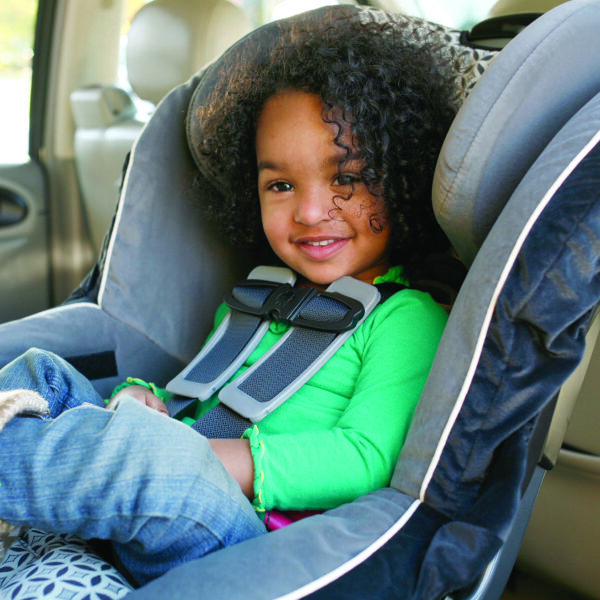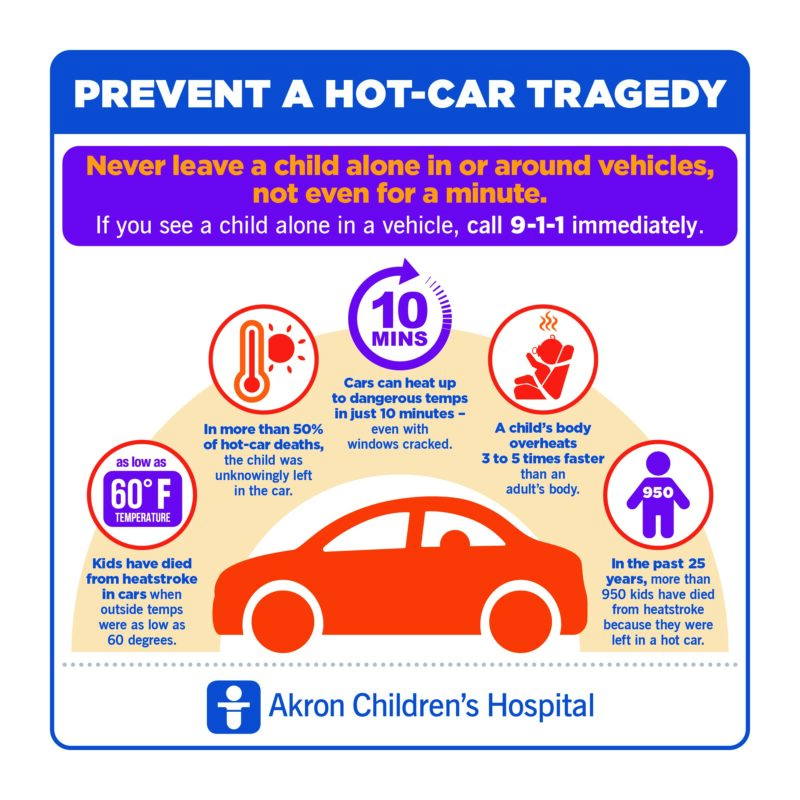
More than 50% of hot car fatalities occur because a child was unknowingly left in a car. Cars can heat up to dangerous temperatures in just 10 minutes on a hot day, but heatstroke can happen on days when temperatures are as low as 57 degrees. Very young children can’t exit the vehicle on their own or alert an adult that they are trapped.
Since 1998, 915 children have died due to heatstroke in vehicles. More than 50% of hot car fatalities occur because a child was unknowingly left in a car. Heatstroke also can happen when a child is left in, or gets trapped in, a car on a hot day. When the outside temperature is 93°F the temperature inside a car can quickly reach 125°F raising body temperature to dangerous levels.
“Children are at particular risk because their bodies heat up 3 to 5 times faster than an adult’s,” says Heather Trnka, injury prevention coalition supervisor for Akron Children’s. “Also, very young children can’t exit the vehicle on their own or alert an adult that they are trapped.”
Cars are like a greenhouse
Cars can heat up to dangerous temperatures in just 10 minutes on a hot day, but heatstroke can happen on days when temperatures are as low as 57 degrees.
“Cars are like a greenhouse. The sunlight passes through the windows and heats up the dash and car seat thus heating up the ambient air,” Heather says. “Cracking the window or parking in the shade does little to cool the car.”
Safety and prevention tips
The following safety and prevention tips for parents and caregivers could mean the difference between life and death:
- Institute a look before you lock routine. Many newer vehicles are equipped with a reminder to look in the back seat. If you are changing your routine, leave something you will need at your destination in the back seat next to the child – even if it’s your left shoe!
- Call. Ask your babysitter or childcare provider to call you if your child hasn’t arrived as scheduled.
- Put the address of your childcare center in your GPS. If your routine is different, put the address of your childcare center in your GPS even if you know the way. That way it prompts you to not forget to drop off your child.
- Keep a stuffed animal in the child’s car seat. Place it on the front passenger seat as a reminder when the child is in the back seat.
- Set the alarm on your cell phone or computer calendar as a reminder to drop your child off at daycare. Make the alarm song/sound different from all other alert sounds on your device.
- Confirm drop off. Communicate with whoever is dropping off the child (spouse, parent or partner) to confirm the drop-off was made.
- Check around. Young children do not know the dangers of getting in an unattended vehicle. If a child is missing, be sure to check any nearby vehicle’s passenger compartment and trunk area.
- Honk the horn. Teach children how to honk the horn. If they find themselves trapped in a car, tell them to honk the horn continuously until an adult comes to help.
- Always keep vehicles locked, even in the garage.
- Keys and key fobs are not toys. Keep them out of reach and out of sight of young children.
- Never leave a child unattended in or around vehicles, not even for a minute.
- Extra vigilance is necessary during busy times like the holidays or changes in routine because this is when many tragedies happen.
- Drive-thru is best. When available, use drive-thru or curb-side services at grocery stores, restaurants, banks and dry cleaners so you don’t have to haul your child in with you.

“Never leave a child in a car, not even for a few minutes to run into the store,” says Heather. “Not only does it increase the risk of heatstroke, but if you leave the car running you also increase the risk of your car being stolen with your child in it.”
If you see a child alone in a vehicle, call 9-1-1 immediately.
“Emergency responders are trained in opening vehicles. They will also get EMS in route to provide medical care,” says Heather. “If a child is in distress, you may have to break the window furthest away from the child, remove the child from the vehicle and get them into a cool environment. Try to cool their body down with water and wait for police and EMS.”
The National Safety Council offers a free online course about the dangers of vehicular heatstroke and children. The training can be completed online using referral code CSB-Gen.
For more information on heat illnesses, visit akronchildrens.org.










